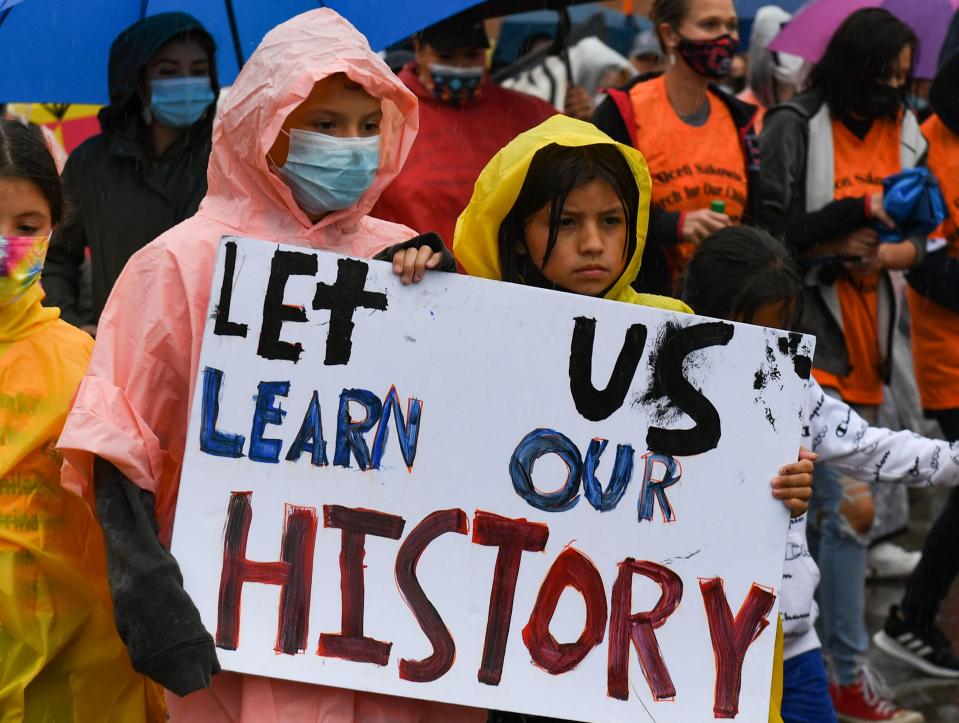Hearing sparks renewed calls to require education on Oceti Sakowin Essential Understandings
Three tribal education directors, and a representative of the South Dakota Education Equity Coalition, would like to see the proposed Oceti Sakowin Essential Understandings standards be a required standard, not an optional one.
Oceti Sakowin means “Seven Council Fires” and refers collectively to the Lakota, Dakota and Nakota people, according to the proposed standard document.
This request was one of several made during opposition testimony time for the OSEUs at the Board of Education Standards meeting held in Aberdeen and livestreamed on Monday morning.

But South Dakota Department of Education Secretary Joe Graves explained in his rebuttal that the only real required standards in South Dakota are for English/Language Arts, math, science and social studies, and that other standard areas like computer science, arts and the OSEUs are optional, but if they’re taught, the standards must be used.
Fred Osborn, director of the Office of Indian Education inside the Department of Tribal Relations, was one of the two proponents who spoke during the meeting and said Native elders, tribal representatives, teachers and community members worked in great detail to make the proposed standard inclusive of all nine tribes.
Osborn told the board that in a 2021 survey with 60-70% of school districts responding, about 45% of educators said they were teaching the OSEUs. In a second survey taken in 2023 with about 20% of districts responding, 62% of educators said they were teaching the OSEUs, Osborn said. The conflicting data means there’s no way to know for sure how many schools are using the OSEUs, Osborn confirmed when a board member asked.
More: Less than half of South Dakota's teachers using Oceti Sakowin Essential Understandings
A bill attempting to require the OSEUs standards failed in 2022.
Consult the ‘people who are part of this history,’ tribal education directors say
Sherry Johnson, tribal education director for the Sisseton Wahpeton Oyate, said she was pleased when the OSEUs came up for a standards review after being adopted in 2018 and was happy to participate in the workgroup, but said she would like to see several changes or inclusions made, like adding each tribe’s origin story.
Cherie Farlee, member and tribal education director for the Cheyenne River Sioux Tribe, said each of the nine tribal nations in South Dakota hold a rich cultural heritage and said students and educators need to see themselves reflected in their education. She encouraged the DOE to hire Native American education specialists.
Brian Wagner, tribal education director for the Lower Brule Sioux Tribe and tribal education consultant for the Crow Creek Sioux Tribe, said he and his fellow opponent speakers support the importance of the OSEUs, “but we need you to understand how important it is to have the people who are part of this history to come and write (the OSEUs standards),” he said.
He added that the state could support its tribes more strongly by mandating the OSEUs.
“If we do not address the lack of knowledge, we will have a barrier,” Wagner said.
More: 'Senseless erasure': Across the U.S., states are reckoning with the need for Indigenous education
Rachel White Buffalo, the research and policy director for the Coalition, said it’s imperative that the standard reflects the experiences of tribal communities, and said the standard should be mandatory.
Johnson, Wagner and White Buffalo all said the pictures used in the standard document, which are mostly landscapes, should be updated to be more representative of all tribes, more modern and more culturally appropriate. Wagner suggested the images could be of tribal members or councilors, and White Buffalo suggested the images should be of Oceti Sakowin individuals from various professions.
White Buffalo and Johnson both pointed to a lack of Dakota inclusion in the proposed standard, which White Buffalo said perpetuates an inequity.
Johnson and White Buffalo also said the use of Wikipedia as a source for glossary terms -- the standard document uses Wikipedia definitions of imperialism, manifest destiny, treaty, tribal sovereignty and winter count -- is inappropriate, isn’t a reliable source, and isn’t a professional source that should be used in education. Those definitions should be developed with elders and educators, White Buffalo said.
Graves said the testimony from people who spoke in-person, online or in written testimony to the board by Monday will be taken into consideration and changes could be made before the second public hearing is held on these standards Nov. 4 in Sioux Falls.
This article originally appeared on Sioux Falls Argus Leader: Tribal education directors call for required Oceti Sakowin standards
